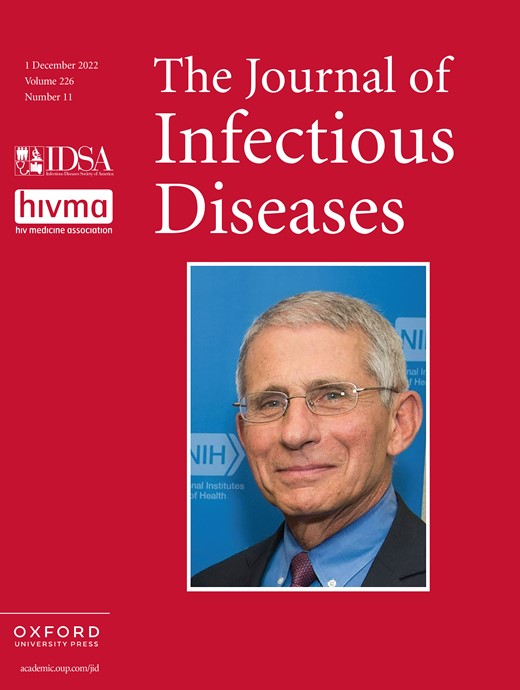
Cover image

Volume 226, Issue 11, 1 December 2022
Editorial
Thank You—Tony Fauci
Perspective
Reliably Assessing Duration of Protection for Coronavirus Disease 2019 Vaccines
We show that modeling vaccine effects as a piecewise exponential function of time since vaccination on the hazard ratio provides more reliable assessment of vaccine efficacy than the traditional method of estimating a constant vaccine effect over each time period.
Review
CRISPR-Cas in Diagnostics and Therapy of Infectious Diseases
We describe the CRISPR-Cas technology and review the scientific literature with focus on different approaches utilizing this technology in diagnostics and treatment of infectious diseases, and discuss the current challenges that might limit the clinical use of CRISPR-Cas in patients.
Major Articles and Brief Reports
Covid-2019
Severe Acute Respiratory Syndrome Coronavirus 2 Anti-Spike Antibody Levels Following Second Dose of ChAdOx1 nCov-19 or BNT162b2 Vaccine in Residents of Long-term Care Facilities in England (VIVALDI)
Antibody responses to vaccination in older residents of long-term care facilities are comparable to those in the general population. Although antibody levels are initially greater, they fall more rapidly following Pfizer-BioNTech vaccination than Oxford-AstraZeneca. Prior infection enhances responses in both groups.
High Attack Rate of Severe Acute Respiratory Syndrome Coronavirus 2 B.1.1.529 Among 2-Dose Vaccinated Populations in 2 Indoor Entertainment Setting Outbreaks
SARS-CoV-2 Omicron attack rates of >50% were found in 2 outbreaks in indoor entertainment venues among populations vaccinated with 2 doses. Our findings demonstrate the importance of nonpharmaceutical public health measures in addition to vaccination to prevent virus transmission.
Cost-effectiveness of Coronavirus Disease 2019 Vaccination in Low- and Middle-Income Countries
With circulating Omicron-like variants, increasing vaccination rates for COVID-19 to 30% or 45% of the population in each low- and middle-income country would have incremental cost-effectiveness ratios of $1040 and $3050, respectively, per year of life saved.
Anti-membrane Antibodies Persist at Least One Year and Discriminate Between Past Coronavirus Disease 2019 Infection and Vaccination
Antimembrane antibodies persist for at least 1 year and are a sensitive and specific marker of past COVID-19 infection. Also, antimembrane and antispike antibodies together can differentiate between COVID-19 convalescent, vaccinated, and naive states.
Correlation Between Postvaccination Anti-Spike Antibody Titers and Protection Against Breakthrough Severe Acute Respiratory Syndrome Coronavirus 2 Infection: A Population-Based Longitudinal Study
Postvaccination anti-spike immunoglobulin (Ig) G, IgA, and IgM titers are modestly predictive of breakthrough severe acute respiratory syndrome coronavirus 2 infection but show poor correlation with interferon γ responses. Their limited predictive value for protection may therefore stem from their inability to reflect protective vaccine-induced cellular responses.
Regimen of Coronavirus Disease 2019 Vaccination Influences Extent and Kinetics of Antibody Avidity
We found a significantly higher avidity of SARS-Cov-2 spike-specific IgG antibodies among subjects vaccinated with regimens that included at least 1 dose of the adenoviral vector vaccine ChAdOx1-S compared with 2 doses of the mRNA vaccine BNT162b2.
Limited Humoral and Specific T-Cell Responses After SARS-CoV-2 Vaccination in PWH With Poor Immune Reconstitution
One third of HIV-1-infected individuals with CD4+ T-cell counts ≤200 cells/mm3 show low anti-S/anti-RBD IgG levels, reduced in vitro neutralization activity against SARS-CoV-2 and no vaccine-induced T-cells 4 weeks after a second dose of COVID-19 mRNA vaccines.
Effectiveness of mRNA Booster Vaccination Against Mild, Moderate, and Severe COVID-19 Caused by the Omicron Variant in a Large, Population-Based, Norwegian Cohort
Understanding how booster vaccination can prevent moderate and severe illness without hospitalization is crucial to evaluate the full advantage of mRNA boosters. In this population-based study, mRNA booster vaccination partly prevented moderate and severe COVID-19, but not mild COVID-19.
Longitudinal Severe Acute Respiratory Syndrome Coronavirus 2 Vaccine Antibody Responses and Identification of Vaccine Breakthrough Infections Among Healthcare Workers Using Nucleocapsid Immunoglobulin G
Vaccine breakthrough rates increased during severe acute respiratory syndrome coronavirus 2 (SARS-CoV-2) Omicron waves and displayed higher spike and nucleocapsid immunoglobulin (Ig) G levels compared with breakthroughs from previous variants. SARS-CoV-2 nucleocapsid IgG is a useful marker for identifying recent coronavirus disease 2019 infection in vaccinated individuals.
Viruses
Association Between Immunogenicity and Reactogenicity: A Post Hoc Analysis of 2 Phase 3 Studies With the Adjuvanted Recombinant Zoster Vaccine
Using phase 3 clinical data for recombinant zoster vaccine, we found a weak but significant association between pain and immunogenicity. Individuals with no pain can still mount strong immune responses, so reactogenicity cannot be used to predict immunity after vaccination.
Predominance of Severe Plasma Leakage in Pediatric Patients With Severe Dengue in Puerto Rico
We evaluated patients with dengue in Puerto Rico. Most cases were among children. Severe plasma leakage was the most common presentation among children, highlighting important differences from adults. Vaccination could help prevent severe dengue among children in Puerto Rico.
Specificity and Breadth of the Neutralizing Antibody Response to a Live-Attenuated Tetravalent Dengue Vaccine
We characterized the specificity and breadth of neutralizing antibody (nAb) response to a live-attenuated tetravalent dengue vaccine candidate and found that the nAb response comprised both type-specific and cross-reactive nAbs, with comparable neutralization of diverse dengue genotypes.
The Cytokines CXCL10 and CCL2 and the Kynurenine Metabolite Anthranilic Acid Accurately Predict Patients at Risk of Developing Dengue With Warning Signs
Stronger activation of the kynurenine pathway is discernible in patients with dengue with warning signs as CCL2, CCL4, CXCL10, IFN-ɣ, and IL-18 are elevated, accompanied by increased kynurenine-tryptophan ratio, anthranilic acid, and picolinic acid.
Association of Neutrophil Mediators With Dengue Disease Severity and Cardiac Impairment in Adults
Cardiac function was impaired and levels of myeloperoxidase were higher in patients with severe dengue than in controls or patients with dengue fever during the critical phase. Myeloperoxidase was inversely associated with cardiac function and may mediate dengue-associated cardiac impairment.
HIV/Aids
Resistance Analyses in Highly Treatment-Experienced People With Human Immunodeficiency Virus (HIV) Treated With the Novel Capsid HIV Inhibitor Lenacapavir
Addition of lenacapavir to optimized background regimen in persistently viremic highly treatment-experienced people with multidrug-resistant HIV led to 81% viral suppression by week 26. Selection of resistance occurred in 8 participants receiving unintended functional lenacapavir monotherapy.
Second-Generation Human Immunodeficiency Virus Integrase Inhibitors Induce Differentiation Dysregulation and Exert Toxic Effects in Human Embryonic Stem Cell and Mouse Models
Toxicity of pregnancy-relevant HIV antiretrovirals were evaluated using 2 human embryonic stem cell models and a pregnancy mouse model. Second-generation integrase inhibitors dolutegravir, bictegravir, and cabotegravir, but not first-generation raltegravir, exhibited toxicity in both in vitro and in vivo models.
Lower Insulin Sensitivity in Newborns With In Utero HIV and Antiretroviral Exposure Who Are Uninfected in Botswana
In utero HIV and antiretroviral (ARV) exposure is associated with lower insulin sensitivity in the first month of life, raising potential concern for obesity and other metabolic perturbations later in life for newborns with perinatal HIV/ARV exposure.
Parasites
Intestinal Injury in Ugandan Children Hospitalized With Malaria
Among Ugandan children hospitalized with severe malaria, markers of intestinal injury (intestinal fatty-acid binding protein and zonula occludens-1) and microbial translocation (lipopolysaccharide binding protein and soluble complement of differentiation-14) were elevated and associated with multiple organ dysfunction and fatal outcome.
Mutant PfCRT Can Mediate Piperaquine Resistance in African Plasmodium falciparum With Reduced Fitness and Increased Susceptibility to Other Antimalarials
We report that Plasmodium falciparum resistance to piperaquine, an artemisinin-based combination therapy drug, can be achieved in an African strain via a single PfCRT point mutation. Resistance is modest compared to Asian strains and comes with a substantial fitness cost.
Pathogenesis and Host Response
DDX58 Is Associated With Susceptibility to Severe Influenza Virus Infection in Children and Adolescents
Retinoic acid–inducible gene I (RIG-I) is important for type I interferon antiviral host immunity against influenza virus infection. Genetic variants in DDX58 encoding RIG-I may influence this response and susceptibility to severe disease in children.



